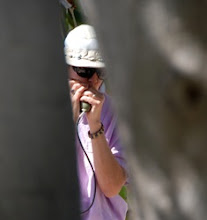15.10.09
www.rozinlapaz.com
If you have trouble finding the site, please e-mail me at rozinlapaz@yahoo.com
29.9.09
16.9.09
The chiles not only looked good, they were indeed delicious – never before had Tita done such a marvelous job with them.
When you bite into a Chile en Nogada, you get a taste of Mexican history and legend. This is the dish that bewitched the wedding guests in Laura Esquivel’s novel, Like Water for Chocolate.
In the novel, the first wedding guest to react to the chiles in walnut
 sauce "immediately recognized the heat in her limbs, the tickling sensation in the center of her body, the naughty thoughts, and she decided to leave with her husband before things went too far. When she left, the party started to break up. " All the other chile-eating guests quickly made their excuses , throwing heated looks at each other, and left. Everyone was in a hurry to make mad passionate love.
sauce "immediately recognized the heat in her limbs, the tickling sensation in the center of her body, the naughty thoughts, and she decided to leave with her husband before things went too far. When she left, the party started to break up. " All the other chile-eating guests quickly made their excuses , throwing heated looks at each other, and left. Everyone was in a hurry to make mad passionate love.The platters of chiles proudly wore the colors of the flag: the green of the chiles, the white of the nut sauce, the red of the pomegranates.
According to some historians, the dish that Esquivel cast as an aphrodisiac was, in fact, invented in the 1800s by nuns in the town of Puebla.
It was August 1821 and pomegranates were in season. The military commander Augustin de Iturbide had just signed the Treaty of Cordoba, granting Mexico its independence from Spain. He was travelling from Veracruz to Mexico City and planned to stop in Puebla, where there would be a feast in his honour. The Augustinian nuns of Santa Monica Convent created a special dish in the colours of the Mexican flag: green chiles, white walnut sauce and red pomegranates.
Nowadays, Chiles en Nogada are served in September, the month Mexicans celebrate Independence Day. It's not an easy dish to prepare, but if you're determined to try, google "chiles en nogada" and "recipes." Take your pick from the dozens of variations listed.
Or look for this dish on the menu at restaurants around town this month. One likely location is El Zarape, which specializes in traditional dishes. It's at 3450 México street (between Oaxaca and Nayarit).
The chiles disappeared in the blink of an eye. How long ago it seemed that Tita had felt like a chile in nut sauce left sitting on the platter out of etiquette, for not wanting to look greedy. Tita wondered whether the fact that there was not a single chile left on the platters was a sign that good manners had been forgotten or that the chiles were indeed splendid.
2.8.09

THROUGH THE LENS OF HISTORY
It is a compelling, enigmatic image of the Mexican Revolution. The woman sits on the train tracks, stares into the camera’s lens. She’s dressed in men’s clothing. Her arms are filled with what look like branches. Behind her, there’s a crowd, most faces concealed in shadow.
The date of the photograph is 1915. The caption reads: “This woman, nicknamed La Destroyer, was famous for helping those who had fallen in battle to die a more rapid and less painful death.”
This photo is from the Casasola Archive, a collection of close to 500,000 images that document the history and culture of modern Mexico. The archive is the work of hundreds of photographers, but the cardinal figure is Agustín Víctor Casasola.
Casasola is among the most important photojournalists of the 20th Century. He and the photographers who worked for his press agency took pictures of everybody: ordinary Mexicans and the famous, alike: Porfirio Díaz at the end of his 30-year reign; revolutionary leaders Emiliano Zapata and Pancho Villa in moments of triumph, and death; artistic and intellectual figures such as Diego Rivera, Frida Kahlo and exiled Russian Leon Trotsky.
With the approach in 2010 of the 100th anniversary of the Mexican Revolution and the 200th anniversary of independence, these pictures take on added interest. At Archivo Histórico Pablo L. Martínez, the government archives in La Paz, you'll find historical images and documents on display until Sept. 30. You may find Casasolas' work there. In any case, here's where you can learn more about the photographer and his pictures:
Mexico: the Revolution and Beyond is a magnificent coffee-table book published by Aperture in cooperation with the Mexican government’s CONACULTA INAH. An excellent introduction by Peter Hamill puts the photographs into historical context. The ISBN number for the hardcover English edition published in 2003 is 1-931788-22-7.
Las Soldaderas: Women of the Mexican Revolution by Mexican journalist and novelist Elena Poniatowska is a slim English-language paperback crammed with fascinating stories, accompanied by Casasola’s photographs, about the women who travelled with the revolutionary armies and often fought alongside their men. Allende Books, La Paz’s English-language bookstore, has copies in stock. Allende Books, open Monday through Saturday 10 a.m. to 6 p.m. is at Independencia #518, between Serdan and G. Prieto. Phone number: 612-125-9114.
Mexconnect’s website has an article online about Casasola. You’ll find it at
http://www.mexconnect.com/articles/1086-the-legacy-of-agustin-victor-casasola-photographer-1874-1938
29.6.09
ROMANCE AND ART CAST A SPELL
El Sortilegio is a soap opera with a bonus. The telenovela -- its English title is "Love Spell" -- uses Mexican art as a backdrop for each episode. That's because the show's producer, Carla Estrada, invited artists from across the country to send in samples of their work. From 900 submissions, well-known Mexican artist José Luis Cuevas helped choose 200 pieces. These have become part of the setting for this hot, new TV series, which began broadcast June 1.
If you have ever tuned in to a Latin American telenovela, you know that these soap operas offer a crash course in conversational Spanish. With Sortilegio, you also get the exposure to contemporary Mexican art, plus a plot thick with intrigue and romance.
Wikipedia describes the telenovela as a melodrama in miniseries format. These shows air in prime time -- five or six nights a week for about six months. They usually end with a bang. They are the most-watched genre of television program in the world, with at least two billion viewers worldwide.
The News, an excellent English-language newspaper in Mexico City, recently published an article on Sortilegio and the tie-in with Mexican art. Here's an excerpt from http://www.thenews.com.mx/
"Sortilegio treads some well-worn but entertaining soap-opera turf. Antonio Lombardo, a successful businessman, becomes alienated by his wife's inability to conceive and henceforth falls in love with and impregnates his best friend Samuel's wife Victoria, who gives birth to twins.
"Samuel goes on raising the children as if they were his own, while later, Antonio's wife dies during childbirth and gives birth to a baby boy. Later, Samuel dies and Antonio and Victoria are able to live life together, with three children completely in the dark as to the true nature of their relationship.”
The children grow to adulthood, and that's when the plot really thickens. A quote from Scottish writer Sir Walter Scott comes to mind: "Oh, what a tangled we weave, when first we practice to deceive."
For a five-minue introduction to Sortilegio, take a look at the English-language trailer on the Web. Go to http://www.dailymotion.com/relevance/search/Jacqueline-Bracamontes/video/x99zsl_sortilegio-trailer-english_shortfilms
The one-hour episodes, created by Televisa, air Monday through Friday at 9 p.m. on "canal de las estrellas" (channel of the stars) in most parts of Mexico. Check local time and channel for La Paz. Sortilegio has been in progress for a month, but with 95 episodes scheduled, there's time to catch up before the story reaches its dramatic conclusion in mid-October.
31.5.09
FROM PAPER MOTH TO BOOKWORM
Pillo Polilla is a paper-devouring moth who lives in a library, where he spends his days happily chewing through the bountiful collection of books. But then Pillo learns to read. And life for the moth turns upside-down.
Pillo finds magic in the world of literature -- everything from Twenty Million Leagues under the Sea to the poetry of Pablo Neruda. But his discovery causes him angst. What does a paper moth eat, if not books? He ventures out of the library on a quest to discover the meaning of his own existence.

The result is a prize-winning theatrical production, told through puppets and actors. La Vida Útil de Pillo Polilla (the useful life of Pillo the Moth) is an adaptation of the novel by Vivian Mansour Manzur, a writer whose witty plots and sense of humor have earned her two prestigious literary awards in Mexico. Lourdes Aguilera (pictured at right) adapted, produced and directed the stage production. The Association of Mexican theatre Critics judged the show to be “Best Children’s Work” in 2006.


